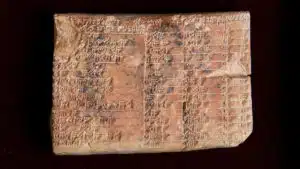Certainly the very word ‘trigonometry’ might bring up a wince in you. Horrible memories from high school or college with sine, cosine, or secant charts. Or maybe you just avoided it because it just sounded terrible. If you heard of it at all.
Let’s make it really easy, though. Trigonometry simply means ‘measuring triangles’ and is a branch of mathematics that is interested in measuring movement and distances of things and angles and using triangles to make it work. If you have ever tried to move a table through a narrow doorway or figure out if you can stay walking at the same pace across a street and not get hit by a car traveling at a steady rate, you were doing trigonometry in your head. In the ancient world it was used for construction and charting astronomy.
Greeks did their math and counting in what is called ‘Base 10’ and it the same base we use in our counting system.
Babylonians did their math and counting in what is called ‘Base 60’. We have remnant of this sexagesimal system in our time keeping – 60 seconds in a minute, 60 minutes in an hour – and measuring angles with 360 degrees in a circle. Also base 60 is still part of longitude and latitude measurements. Hey, Babylonians also gave us zero. So, thanks Babylonia!
Base 60 is very flexible and has lots of benefits and…we don’t use it because our understanding of math came from the Greeks.
It happens to be that trigonometry the way the Greeks conceived of it, about 2500 years ago, absolutely works, but it is hard. Even for them. Base 10 isn’t really good for the math of trigonometry. Take my word for it. You might recall from a geometry class years ago using a protractor to measure angles. The Greek method of trigonometry requires measuring or predicting the internal angles of triangles usually when the triangle is placed inside a circle. It’s complicated.
Don’t worry too much about the particulars here…just go with me here! Greek trigonometry is hard because it works in base 10 and involves lots of interior angle measuring and predicting with triangles in a circle.
A Babylonian tablet, called Plimpton 322, which is about 4000 years old, much older than Greece or the Greeks even thinking about trigonometry, was recently translated from its cuneiform. And it was a trigonometric table done in base 60, so much more accurate, and much simpler but done in a completely different way even beyond base 60. The Babylonians used ratios based on the sides of squares and rectangles.
This tablet, found in the 1930’s was known to be a math table but they couldn’t figure out what it was talking about because all the people working on it only knew Greek style trigonometry. Daniel Mansfield from the University of New South Wales said of the tablet and the discovery
“This is a whole different way of looking at trigonometry. We prefer sines and cosines… but we have to really get outside our own culture to see from their perspective to be able to understand it.”
Now nobody truly knows why the better and easier method of trigonometry was forgotten for more than a thousand years and then a harder and worse one was invented.
But I have a pretty good guess why and it has everything to do with culture and how the land speaks through a culture.
The Babylonians lived in what is called ‘The Fertile Crescent,’ a big flat plain near the Tigris and Euphrates rivers. This area is one place where agriculture really started to be intensively practiced. In dividing up their land for parcels it was a bit like drawing on a huge flat and square piece of paper. The plots were all rectangular and regular sized. Some were bigger, of course, and some were smaller, but they were dependably rectangular.
The Greeks also had agriculture but their land was much more rocky, irregularly shaped, steep, and harder to till.
So here is my guess – The Babylonians created a trigonometry that relied on rectangles and the ratios of the sides because the land trained their eyes to see the world that way. Greeks created a trigonometry that relied on internal angles and triangles because the nature of their land made them look, and therefore see, in a more interior and less expansive fashion.
Now I don’t know that I am right or not but there is evidence that climate and altitude can impact the structure and sound of a language, so it isn’t out of the realm of possibility that terrain and geography could shape how a culture would devise more complicated math.
You might be wondering at this point…’this is maybe a little interesting’ or ‘where is he going with this?’
This piece isn’t to laud Babylonian trigonometry as being superior and Greek trigonometry but to have an example of when a culture is really in touch and relationship with their landscape that their work in the world will be an expression of their environment somehow and to understand how we proceed in the world as sometimes being hard and complicated it could have something to do with a challenging geography that we inhabit that impacts not only our eyes but the very capacity to see in a certain way.
My wish is that these stories and Primal Derma is a small part of retraining our eyes towards a different kind of landscape that will allow us to see outside of our usual story and biases like those mathematicians had to do to understand Plimpton 322.
Thanks for wondering about this.
Until soon enough,
Matt

